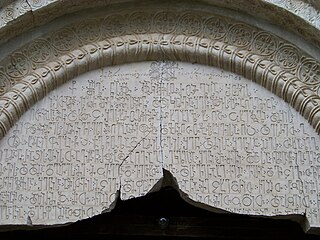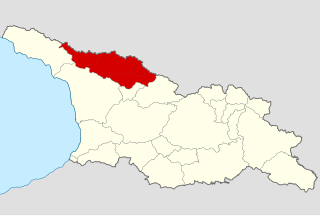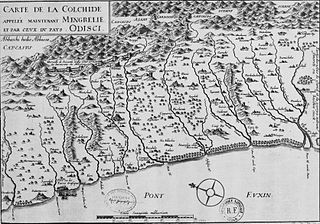Related Research Articles

Georgian is the most widely spoken Kartvelian language; it also serves as the literary language or lingua franca for speakers of related languages. It is the official language of Georgia and the native or primary language of 87.6% of its population. Its speakers today amount to approximately four million. Georgian is written in its own unique alphabet.

The Georgian scripts are the three writing systems used to write the Georgian language: Asomtavruli, Nuskhuri and Mkhedruli. Although the systems differ in appearance, their letters share the same names and alphabetical order and are written horizontally from left to right. Of the three scripts, Mkhedruli, once the civilian royal script of the Kingdom of Georgia and mostly used for the royal charters, is now the standard script for modern Georgian and its related Kartvelian languages, whereas Asomtavruli and Nuskhuri are used only by the Georgian Orthodox Church, in ceremonial religious texts and iconography.

The Georgians, or Kartvelians, are a nation and indigenous Caucasian ethnic group native to Georgia and the South Caucasus. Georgian diaspora communities are also present throughout Russia, Turkey, Greece, Iran, Ukraine, United States, and European Union.
Aorist verb forms usually express perfective aspect and refer to past events, similar to a preterite. Ancient Greek grammar had the aorist form, and the grammars of other Indo-European languages and languages influenced by the Indo-European grammatical tradition, such as Middle Persian, Sanskrit, Armenian, the South Slavic languages, Georgian, and Pashto also have forms referred to as aorist.

Svaneti or Svanetia is a historic province in the northwestern part of Georgia. It is inhabited by the Svans, an ethnic subgroup of Georgians.

The Laz language or Lazuri is a Kartvelian language spoken by the Laz people on the southeastern shore of the Black Sea. In 2007, it was estimated that there were around 20,000 native speakers in Turkey, in a strip of land extending from Melyat to the Georgian border, and around 1,000 native speakers around Adjara in Georgia. There are also around 1,000 native speakers of Laz in Germany.

Mingrelian or Megrelian is a Kartvelian language spoken in Western Georgia, primarily by the Mingrelians. The language was also called Kolkhuri in the early 20th century. Mingrelian has historically been only a regional language within the boundaries of historical Georgian states and then modern Georgia, and the number of younger people speaking it has decreased substantially, with UNESCO designating it as a "definitely endangered language".

Svan is a Kartvelian language spoken in the western Georgian region of Svaneti primarily by the Svan people. With its speakers variously estimated to be between 30,000 and 80,000, the UNESCO designates Svan as a "definitely endangered language". It is of particular interest because it has retained many archaic features that have been lost in the other Kartvelian languages.

The Svans are an ethnic subgroup of the Georgians (Kartvelians) living mostly in Svaneti, a region in northwest Georgia. They speak the Svan language and are mostly bilingual also in Georgian. Both these languages belong to the Kartvelian language family. In the pre-1930 Soviet census, the Svans were afforded their own "ethnic group" (natsional'nost) category. The self-designation of the Svan is Mushüan, which is probably reflected in the ethnonym Misimian of the Classical authors.

Odishi was a historical district in western Georgia, the core fiefdom of the former Principality of Mingrelia, with which the name "Odishi" was frequently coterminous. Since the early 19th century, this toponym has been supplanted by Mingrelia (Samegrelo).
Georgian grammar has many distinctive and extremely complex features, such as split ergativity and a polypersonal verb agreement system.

The Mingrelians are an indigenous Kartvelian-speaking ethnic subgroup of Georgians that mostly live in the Samegrelo-Zemo Svaneti region of Georgia. They also live in considerable numbers in Abkhazia and Tbilisi. In the pre-1930 Soviet census, the Mingrelians were afforded their own ethnic group category, alongside many other ethnic subgroups of Georgians.

Skolt Sámi is a Uralic, Sámi language that is spoken by the Skolts, with approximately 300 speakers in Finland, mainly in Sevettijärvi and approximately 20–30 speakers of the Njuõʹttjäuʹrr (Notozero) dialect in an area surrounding Lake Lovozero in Russia. Skolt Sámi also used to be spoken in the Neiden area of Norway. It is written using a modified Roman orthography which was made official in 1973.
The Dvals were a ethnographic group of Georgians and Ossetians, their lands lying on both sides of the central Greater Caucasus mountains, somewhere between the Darial and Mamison gorges. This historic territory mostly covers the north of Kartli, parts of the Racha and Khevi regions in Georgia and south of Ossetia in Russia.
Georgian is a Kartvelian language spoken by about 4 million people, primarily in Georgia but also by indigenous communities in northern Turkey and Azerbaijan, and the diaspora, such as in Russia, Turkey, Iran, Europe, and North America. It is a highly standardized language, with established literary and linguistic norms dating back to the 5th century.
The Proto-Kartvelian language, or Common Kartvelian, is the linguistic reconstruction of the common ancestor of the Kartvelian languages, which was spoken by the ancestors of the modern Kartvelian peoples. The existence of such a language is widely accepted by specialists in linguistics, who have reconstructed a broad outline of the language by comparing the existing Kartvelian languages against each other. Several linguists, namely, Gerhard Deeters and Georgy Klimov have also reconstructed a lower-level proto-language called Proto-Karto-Zan or Proto-Georgian-Zan, which is the ancestor of Karto-Zan languages.

The Kartvelian languages are a language family indigenous to the South Caucasus and spoken primarily in Georgia. There are approximately 5.2 million Kartvelian speakers worldwide, with large groups in Russia, Iran, the United States, the European Union, Israel, and northeastern Turkey. The Kartvelian family has no known relation to any other language family, making it one of the world's primary language families.

The Zan languages, or Zanuri or Colchidian, are a branch of the Kartvelian languages constituted by the Mingrelian and Laz languages. The grouping is disputed as some Georgian linguists consider the two to form a dialect continuum of one Zan language. This is often challenged on the most commonly applied criteria of mutual intelligibility when determining borders between languages, as Mingrelian and Laz are only partially mutually intelligible, though speakers of one language can recognize a sizable amount of vocabulary of the other, primarily due to semantic loans, lexical loans and other areal features resulting from geographical proximity and historical close contact common for dialect continuums.
Laz is a South Caucasian language. It is sometimes considered as a southern dialect of Zan languages, the northern dialect being the Mingrelian language.
The Karto-Zan languages, also known as Georgian-Zan, are a branch of the Kartvelian language family that contains the Georgian and Zan languages. The Svan language forms the other branch of the Kartvelian family, showing characteristic differences from the Karto-Zan group. It has been hypothesized that the divergence between Svan and Proto-Kartvelian goes back as far as the 19th century BCE. Georgian and Zan on the other hand diversified from Proto-Georgian-Zan during the 7th century BCE. Both languages share common archaic words related to metallurgy and agriculture absent in Svan.
References
- Chikobava, Arn. (1936). Grammatical analysis of Laz with texts (in Georgian). Tiflis.
{{cite book}}: CS1 maint: location missing publisher (link) - Chikobava, Arn. (1938). Chan-Megrel-Georgian Comparative Dictionary (in Georgian). Tbilisi.
{{cite book}}: CS1 maint: location missing publisher (link) - Fähnrich, H. & Sardzhveladze, Z. (2000). Etymological Dictionary of the Kartvelian Languages (in Georgian). Tbilisi.
{{cite book}}: CS1 maint: location missing publisher (link) CS1 maint: multiple names: authors list (link) - Kajaia, O. (2001–2002). Megrelian-Georgian dictionary. 3 Vols. (in Georgian). Tbilisi.
{{cite book}}: CS1 maint: location missing publisher (link) - Kartozia, G. (2005). The Laz language and its place in the system of Kartvelian languages (in Georgian). Tbilisi.
{{cite book}}: CS1 maint: location missing publisher (link) - Klimov, G. (1964). Etymological Dictionary of the Kartvelian Languages (in Russian). Moscow.
{{cite book}}: CS1 maint: location missing publisher (link) - Klimov, G. (1998a). Etymological Dictionary of the Kartvelian Languages. Berlin: Mouton de Gruyter.
- Klimov, G. (1998b). Languages of the World: Caucasian languages (in Russian). Moscow: Academia.
- Marr [Марръ], N. [Н.] (1910). Грамматика ̔чанскаго (лазскаго) языка съ хрестоматіею и словаремъ[Grammar of Chan (Laz) with chrestomathy and dictionary (in Russian)]. St. Petersburg.
{{cite book}}: CS1 maint: location missing publisher (link) - Qipshidze, I. (1914). The Grammar of Megrelian (Iver) Language with reader and dictionary. St. Petersburg.
{{cite book}}: CS1 maint: location missing publisher (link). (in Russian and Mingrelian) - Shanidze, A. (1973). Essentials of Georgian Grammar (in Georgian). Tbilisi.
{{cite book}}: CS1 maint: location missing publisher (link) - Topuria, V. & Kaldani, M. (2000). Svan Dictionary (in Georgian). Tbilisi.
{{cite book}}: CS1 maint: location missing publisher (link) CS1 maint: multiple names: authors list (link)